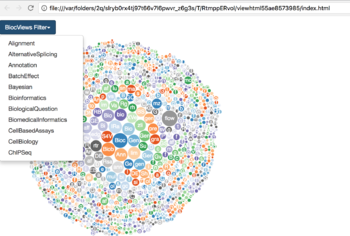Bioconductor
Release News
Github mirror
- https://support.bioconductor.org/p/68824/ Announcement (Update: it is dead)
Package source
BiocManager from CRAN
The reason for using BiocManager instead of biocLite() is mostly to stop sourcing an R script from URL which isn’t so safe. So biocLite() should not be recommended anymore.
It allows to have multiple versions of Bioconductor installed on the same computer. For example, R 3.5 works with Bioconductor 3.7 and 3.8.
On the other hand, setRepositories(ind=1:4) and install.packages() still lets you install Bioconductor packages.
BioCExplorer
Explore Bioconductor packages more nicely
source("https://bioconductor.org/biocLite.R")
biocLite("BiocUpgrade")
biocLite("biocViews")
devtools::install_github("seandavi/BiocPkgTools")
devtools::install_github("shians/BioCExplorer")
library(BioCExplorer)
bioc_explore()
Annotation packages
- http://bioconductor.org/help/course-materials/2012/SeattleFeb2012/Annotation.pdf
- https://bioconductor.org/help/course-materials/2017/CSAMA/lectures/1-monday/lecture-04-a-annotation-intro/lecture-04a-annotation-intro.html
- Making and Utilizing TxDb Objects
- Genomic Annotation Resources Introduction to using gene, pathway, gene ontology, homology annotations and the AnnotationHub. Access GO, KEGG, NCBI, Biomart, UCSC, vendor, and other sources.
- AnnotationHub
- OrgDb
- TxDb
- OrganismDb
- BSgenome
- biomaRt
- http://genomicsclass.github.io/book/pages/bioc1_annoCheat.html
- ensembldb package
Gene centric
Genomic centric
Web based
Workflow
Using Bioconductor for Sequence Data
Some packages
Biobase, GEOquery and limma
How to create an ExpressionSet object from scratch? Here we use the code from GEO2R to help to do this task.
library(Biobase)
library(GEOquery)
library(limma)
# Load series and platform data from GEO
gset <- getGEO("GSE32474", GSEMatrix =TRUE, AnnotGPL=TRUE)
if (length(gset) > 1) idx <- grep("GPL570", attr(gset, "names")) else idx <- 1
gset <- gset[[idx]]
# save(gset, file = "~/Downloads/gse32474_gset.rda")
# load("~/Downloads/gse32474_gset.rda")
table(pData(gset)[, "cell line:ch1"])
pData(gset)
# Create an ExpressionSet object from scratch
# We take a shortcut to obtain the pheno data and feature data matrices
# from the output of getGEO()
phenoDat <- new("AnnotatedDataFrame",
data=pData(gset))
featureDat <- new("AnnotatedDataFrame",
data=fData(gset))
exampleSet <- ExpressionSet(assayData=exprs(gset),
phenoData=phenoDat,
featureData=featureDat,
annotation="hgu133plus2")
gset <- exampleSet
# Make proper column names to match toptable
fvarLabels(gset) <- make.names(fvarLabels(gset))
# group names for all samples
gsms <- paste0("00000000111111111XXXXXXXXXXXXXXXXXXXXXXXXXXXXXXXXX",
"XXXXXXXXXXXXXXXXXXXXXXXXXXXXXXXXXXXXXXXXXXXXXXXXXX",
"XXXXXXXXXXXXXXXXXXXXXXXXXXXXXXXXXXXXXXXXXXXXXXXXXX",
"XXXXXXXXXXXXXXXXXXXXXXXX")
sml <- c()
for (i in 1:nchar(gsms)) { sml[i] <- substr(gsms,i,i) }
# Subset an ExpressionSet by eliminating samples marked as "X"
sel <- which(sml != "X")
sml <- sml[sel]
gset <- gset[ ,sel]
# Decide if it is necessary to do a log2 transformation
ex <- exprs(gset)
qx <- as.numeric(quantile(ex, c(0., 0.25, 0.5, 0.75, 0.99, 1.0), na.rm=T))
LogC <- (qx[5] > 100) ||
(qx[6]-qx[1] > 50 && qx[2] > 0) ||
(qx[2] > 0 && qx[2] < 1 && qx[4] > 1 && qx[4] < 2)
if (LogC) { ex[which(ex <= 0)] <- NaN
exprs(gset) <- log2(ex) }
# Set up the data and proceed with analysis
sml <- paste("G", sml, sep="") # set group names
fl <- as.factor(sml)
gset$description <- fl
design <- model.matrix(~ description + 0, gset)
colnames(design) <- levels(fl)
fit <- lmFit(gset, design)
cont.matrix <- makeContrasts(G1-G0, levels=design)
fit2 <- contrasts.fit(fit, cont.matrix)
fit2 <- eBayes(fit2, 0.01)
tT <- topTable(fit2, adjust="fdr", sort.by="B", number=250)
# Display the result with selected columns
tT <- subset(tT, select=c("ID","adj.P.Val","P.Value","t","B","logFC","Gene.symbol","Gene.title"))
tT[1:2, ]
# ID adj.P.Val P.Value t B logFC Gene.symbol
# 209108_at 209108_at 0.08400054 4.438757e-06 6.686977 3.786222 3.949088 TSPAN6
# 204975_at 204975_at 0.08400054 6.036355e-06 6.520775 3.550036 2.919995 EMP2
# Gene.title
# 209108_at tetraspanin 6
# 204975_at epithelial membrane protein 2
Biostrings
- Find the location of a particular sequence. ?vmatchPattern
- https://www.bioconductor.org/help/course-materials/2011/BioC2011/LabStuff/BiostringsBSgenomeOverview.pdf
library(Biostrings)
library(BSgenome.Hsapiens.UCSC.hg19)
vmatchPattern("GCGATCGC", Hsapiens)
plyranges
http://bioconductor.org/packages/devel/bioc/vignettes/plyranges/inst/doc/an-introduction.html
Misc
Package release history
https://support.bioconductor.org/p/69657/
Search the DESCRIPTION file (eg. VariantAnnotation package) in github and the release information can be found there.
